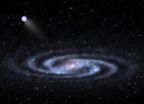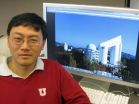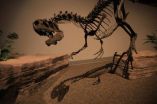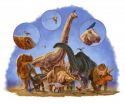(Press-News.org) SALT LAKE CITY, May 7, 2014 – A University of Utah-led team discovered a "hypervelocity star" that is the closest, second-brightest and among the largest of 20 found so far. Speeding at more than 1 million mph, the star may provide clues about the supermassive black hole at the center of our Milky Way and the halo of mysterious "dark matter" surrounding the galaxy, astronomers say.
"The hypervelocity star tells us a lot about our galaxy – especially its center and the dark matter halo," says Zheng Zheng, an assistant professor of physics and astronomy and lead author of the study published recently in Astrophysical Journal Letters by a team of U.S. and Chinese astronomers.
"We can't see the dark matter halo, but its gravity acts on the star," Zheng says. "We gain insight from the star's trajectory and velocity, which are affected by gravity from different parts of our galaxy."
In the past decade, astronomers have found about 20 of these odd stars. Hypervelocity stars appear to be remaining pairs of binary stars that once orbited each other and got too close to the supermassive black hole at the galaxy's center. Intense gravity from the black hole – which has the mass of 4 million stars like our sun – captures one star so it orbits the hole closely, and slingshots the other on a trajectory headed beyond the galaxy.
Zheng and his colleagues discovered the new hypervelocity star while conducting other research into stars with the Large Sky Area Multi-Object Fiber Spectroscopic Telescope, or LAMOST, located at the Xinglong Observing Station of the National Astronomical Observatories of China, about 110 miles northeast of Beijing. LAMOST boasts a 13.1-foot-wide aperture and houses 4,000 optical fibers, which capture "spectra" or light-wavelength readings from as many as 4,000 stars at once. A star's spectrum reveals information about its velocity, temperature, luminosity and size.
LAMOST's main purpose is to study the distribution of stars in the Milky Way, and thus the galaxy's structure. The new hypervelocity star – named LAMOST-HVS1 – stood out because its speed is almost three times the usual star's 500,000-mph pace through space: 1.4 million mph relative to our solar system. Its speed is about 1.1 million mph relative to the speed of the center of the Milky Way.
Despite being the closest hypervelocity star, it nonetheless is 249 quadrillion miles from Earth. (In U.S. usage, a quadrillion is 1,000,000,000,000,000 miles or 10 to the 15th power, or 1 million billion).
"If you're looking at a herd of cows, and one starts going 60 mph, that's telling you something important," says Ben Bromley, a University of Utah physics and astronomy professor who was not involved with Zheng's study. "You may not know at first what that is. But for hypervelocity stars, one of their mysteries is where they come from – and the massive black hole in our galaxy is implicated."
The Down-Low on a Fast and Loose Star
A cluster of known hypervelocity stars, including the new one, is located above the disk of our Milky Way galaxy, and their distribution in the sky suggests they originated near the galaxy's center, Zheng says.
The diameter of the visible part of our spiral-shaped galaxy is at least 100,000 light years, or 588 quadrillion miles. Zheng says that when the halo of dark matter is added, the estimated diameter is roughly 1 million light years, or 5,880 quadrillion miles.
Scientists know dark matter halos surround galaxies because the way their gravity affects the motion of a galaxy's visible stars and gas clouds. Researchers say only about 5 percent of the universe is made of visible matter, 27 percent is invisible and yet-unidentified dark matter and 68 percent is even more mysterious dark energy, responsible for accelerating the expansion of the universe. By traveling through the dark matter halo, the new hypervelocity star's speed and trajectory can reveal something about the mysterious halo.
Our solar system is roughly 26,000 light years or 153 quadrillion miles from the center of the galaxy – more than halfway out from the center of the visible disk.
By comparison, the new hypervelocity star is about 62,000 light years or 364 quadrillion miles from the galactic center, beyond as well as above the galaxy's visible disk. It is about 42,400 light years from Earth, or about 249 quadrillion miles away.
As far as that is – the star has a magnitude of about 13, or 630 times fainter than stars that barely can be seen with the naked eye – it nevertheless "is the nearest, second-brightest, and one of the three most massive hypervelocity stars discovered so far," Zheng says.
It is nine times more massive than our sun, which makes it very similar to another hypervelocity star known as HE 0437-5439, discovered in 2005, and both are smaller than HD 271791, which was discovered in 2008 and is 11 times more massive than the sun. As seen from Earth, only HD 271791 is brighter than LAMOST-HVS1, Zheng says.
The newly discovered hypervelocity star also outshines our own sun: It is four times hotter and about 3,400 times brighter (if viewed from the same distance). But compared with our 4.6-billion-year-old sun, the newly discovered LAMOST–HVS1 is a youngster born only 32 million years ago, based on its speed and position, Zheng says.
Is there any chance that the supermassive black hole might hurl a hypervelocity star in Earth's direction one day? Not really, Zheng says. First, astrophysicists estimate only one hypervelocity star is launched every 100,000 years. Second, possible trajectories of stars near the supermassive black hole don't forebode any danger, should any of them become a hypervelocity star in the future.
INFORMATION:
Collaborating Institutions and Funding
Zheng conducted the study with researchers from Rensselaer Polytechnic Institute, Troy, N.Y.; National Optical Astronomy Observatory, Tucson, Ariz.; National Astronomical Observatories, Chinese Academy of Sciences, Beijing and Nanjing; Spitzer Science Center, Pasadena, Calif.; University of California Observatories-Lick Observatory, University of California, Santa Cruz; Georgia State University, Atlanta; Fermi National Accelerator Laboratory, Batavia, Ill.; and University of Science and Technology of China, Hefei.
The study was funded by the U.S. National Science Foundation and the National Development and Reform Commission of China.
University of Utah Communications
75 Fort Douglas Boulevard, Salt Lake City, UT 84113
801-581-6773 fax: 801-585-3350
http://www.unews.utah.edu
Nearest bright 'hypervelocity star' found
Speeding at 1 million mph, it probes black hole and dark matter
2014-05-07
ELSE PRESS RELEASES FROM THIS DATE:
All teeth and claws? New study sheds light on dinosaur claw function
2014-05-07
Theropod dinosaurs, a group which includes such famous species as Tyrannosaurus rex and Velociraptor, are often regarded as carnivorous and predatory animals, using their sharp teeth and claws to capture and dispatch prey. However, a detailed look at the claws on their forelimbs revealed that the form and shape of theropod claws are highly variable and might also have been used for other tasks.
Inspired by this broad spectrum of claw morphologies, Dr Stephan Lautenschlager from Bristol's School of Earth Sciences studied the differences in claw shape and how these are ...
Revealing the healing of Dino-sores
2014-05-07
Scientists have used state-of-the-art imaging techniques to examine the cracks, fractures and breaks in the bones of a 150 million-year-old predatory dinosaur.
The University of Manchester researchers say their groundbreaking work – using synchrotron-imaging techniques – sheds new light, literally, on the healing process that took place when these magnificent animals were still alive.
The research, published in the Royal Society journal Interface, took advantage of the fact that dinosaur bones occasionally preserve evidence of trauma, sickness and the subsequent signs ...
Study finds pregnant women show increased activity in right side of brain
2014-05-07
Pregnant women show increased activity in the area of the brain related to emotional skills as they prepare to bond with their babies, according to a new study by scientists at Royal Holloway, University of London.
The research, which will be presented at the British Psychological Society's annual conference on Wednesday 7 May, found that pregnant women use the right side of their brain more than new mothers do when they look at faces with emotive expressions.
"Our findings give us a significant insight into the 'baby brain' phenomenon that makes a woman more sensitive ...
Mass vaccination campaigns reduce the substantial burden of yellow fever in Africa
2014-05-07
Yellow fever, an acute viral disease, is estimated to have been responsible for 78,000 deaths in Africa in 2013 according to new research published in PLOS Medicine this week. The research by Neil Ferguson from Imperial College London, UK and colleagues from Imperial College, WHO and other institutions also estimates that recent mass vaccination campaigns against yellow fever have led to a 27% decrease in the burden of yellow fever across Africa in 2013.
Yellow fever is a serious viral disease that affects people living in and visiting tropical regions of Africa and ...
Water from improved sources is not consistently safe
2014-05-07
Although water from improved sources (such as piped water and bore holes) is less likely to contain fecal contamination than water from unimproved sources, improved sources in low- and middle-income countries are not consistently safe, according to a study by US and UK researchers, published in this week's PLOS Medicine.
These findings are important as WHO and UNICEF track progress towards the Millennium Development Goals water target using the indicator "use of an improved source": this study shows that assuming that "improved" water sources are safe greatly overestimates ...
Dinosaurs and birds kept evolving by shrinking
2014-05-07
Although most dinosaurs went extinct 65 million years ago, one dinosaur lineage survived and lives on today as a major evolutionary success story – the birds. But to what does this lineage owe its success? A study that has 'weighed' hundreds of dinosaurs now suggests that shrinking their bodies may have helped this group to continue exploiting new ecological niches throughout their evolution, and to become such a diverse and widespread group of animals today.
An international team, led by scientists from Oxford University and the Royal Ontario Museum, estimated the body ...
Shrinking helped dinosaurs and birds to keep evolving
2014-05-07
A study that has 'weighed' hundreds of dinosaurs suggests that shrinking their bodies may have helped the group that became birds to continue exploiting new ecological niches throughout their evolution, and become hugely successful today.
An international team, led by scientists at Oxford University and the Royal Ontario Museum, estimated the body mass of 426 dinosaur species based on the thickness of their leg bones. The team found that dinosaurs showed rapid rates of body size evolution shortly after their origins, around 220 million years ago. However, these soon slowed: ...
Patients with AMD may not need monthly injections
2014-05-07
Orlando, Fla. — Researchers have found that, contrary to prvious clinical trial findings, monthly injections to counteract age-related macular degeneration (AMD) may not be necessary. The research is being presented at the 2014 Annual Meeting of the Association for Research in Vision and Ophthalmology (ARVO) this week in Orlando, Fla.
The investigators used a strategy called "treat and extend" to conduct the study, in which the frequency of office visits and injections were tailored to each patient's individual response to therapy. Following 185 patients over a three-and-a-half-year ...
AGU journal highlights -- May 6, 2014
2014-05-06
The following highlights summarize research papers that have been recently published in Geophysical Research Letters (GRL), Journal of Geophysical Research: Earth Surface (JGR-F), Journal of Geophysical Research: Oceans (JGR-C), and Water Resources Research (WRR).
In this release:
1. Polar hexagon-shaped jet stream could reveal Saturn's rotational period
2. Antarctica's Whillans Ice Plain ice flows are highly variable
3. Climate change, water rights, and agriculture: A case study in Idaho
4. Low impact development boosts groundwater recharge
5. Beaufort Gyre sea ...
Black male incarceration can compromise research studies
2014-05-06
Federal restrictions on including prisoners in medical research have negatively impacted research involving black men, who are disproportionately imprisoned, according to a study by Yale School of Medicine researchers. Because individuals who are already in ongoing studies must be dropped if they are incarcerated, this compromises the ability of researchers to examine racial disparities in health outcomes studies.
Published in the May issue of the journal Health Affairs, the study found that during the past three decades, high rates of incarceration of black men may ...
LAST 30 PRESS RELEASES:
The Ceramic Society of Japan’s Oxoate Ceramics Research Association launches new international book project
Heart-brain connection: international study reveals the role of the vagus nerve in keeping the heart young
Researchers identify Rb1 as a predictive biomarker for a new therapeutic strategy in some breast cancers
Survey reveals ethical gaps slowing AI adoption in pediatric surgery
Stimulant ADHD medications work differently than thought
AI overestimates how smart people are, according to HSE economists
HSE researchers create genome-wide map of quadruplexes
Scientists boost cell "powerhouses" to burn more calories
Automatic label checking: The missing step in making reliable medical AI
Low daily alcohol intake linked to 50% heightened mouth cancer risk in India
American Meteorological Society announces Rick Spinrad as 2026 President-Elect
Biomass-based carbon capture spotlighted in newly released global climate webinar recording
Illuminating invisible nano pollutants: advanced bioimaging tracks the full journey of emerging nanoscale contaminants in living systems
How does age affect recovery from spinal cord injury?
Novel AI tool offers prognosis for patients with head and neck cancer
Fathers’ microplastic exposure tied to their children’s metabolic problems
Research validates laboratory model for studying high-grade serous ovarian cancer
SIR 2026 delivers transformative breakthroughs in minimally invasive medicine to improve patient care
Stem Cell Reports most downloaded papers of 2025 highlight the breadth and impact of stem cell research
Oxford-led study estimates NHS spends around 3% of its primary and secondary care budget on the health impacts of heat and cold in England
A researcher’s long quest leads to a smart composite breakthrough
Urban wild bees act as “microbial sensors” of city health.
New study finds where you live affects recovery after a hip fracture
Forecasting the impact of fully automated vehicle adoption on US road traffic injuries
Alcohol-related hospitalizations from 2016 to 2022
Semaglutide and hospitalizations in patients with obesity and established cardiovascular disease
Researchers ‘listen in’ to embryo-mother interactions during implantation using a culture system replicating the womb lining
How changing your diet could help save the world
How to make AI truly scalable and reliable for real-time traffic assignment?
Beyond fragmented markets: A new framework for efficient and stable ride-pooling
[Press-News.org] Nearest bright 'hypervelocity star' foundSpeeding at 1 million mph, it probes black hole and dark matter





